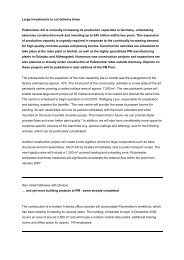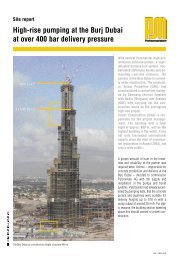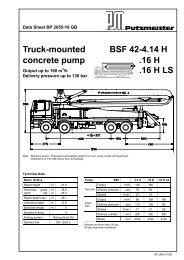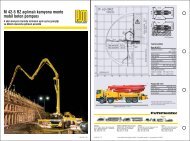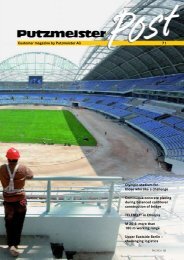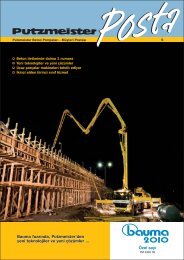2005 - Putzmeister
2005 - Putzmeister
2005 - Putzmeister
- No tags were found...
Create successful ePaper yourself
Turn your PDF publications into a flip-book with our unique Google optimized e-Paper software.
18PM 3652 GBTunnel ConstructionSecuring the Sedrun section of the NEATwith wet spray shotcreteOn the construction sections of the 57 kmGotthard Base Tunnel, numerous concretespray systems are being used all day, everyday by the Sika-<strong>Putzmeister</strong> alliance. Onthe middle section of the Sedrun project,the tunnel builders are working underextremely difficult conditions with fourSika-<strong>Putzmeister</strong> type 500 wet spray units.The Gotthard Base Tunnel is at the heart ofthe new Transalpine Railway (NEAT),which links rail passengers and rail freightthrough Switzerland to European highspeed rail networks. The track is beingbuilt as a flat railway underneath the mainridge of the Swiss Alps, in contrast to theold Gotthard tunnel which was situated atan altitude of 1,100 metres. At 550 m, thenew apex is just 130 m higher than thecentral station in Zurich. This satisfies animportant pre-requisite, meaning that asfrom the year 2015 – according to planning– trains travelling at up to 250 km/h (orgoods trains travelling up to 160 km/h) canpass through Switzerland on the northsouthaxis. The two tunnels will run parallelto each other separated by 40 m. Thetunnels are connected by transverse tunnelsat 300 m intervals.Since the track is being laid in two singletracktunnels and to shorten the constructiontime, several lateral access gatewayswill be required, a total of 153.4 km oftunnels, cross-tunnels and shafts will needto be built to cross the Gotthard mountainrange. The tunnels have been subdividedinto the following sections: Erstfeld,Amsteg, Sedrun, Faido and Bodio. Whilstfour of these project sections are being progressedvia the north and south portals orvia lateral mid-section cross-tunnels, theSedrun tunnel section can only be reachedvia two shafts situated very close to eachother (Ø 7 and 8 m), which have been sunkup to 800 m deep. From the common shafthead, a 1,000 m long cross-tunnel with arail system and also a 450 m long horizontalventilation cross-tunnel lead to the openair. The two shafts create the connection tothe tunnel level from which the Sedrunmulti function zone excavations are beingblasted out of the rock. The two tunnelsections – each 6.2 km long – has beendriven from here in both north and southTemporaryaccommodationDiagram of the Sedrun section of theGotthard Base Tunnel(Diagram: AlpTransit Gotthard AG)Sedruntunneldirections since summer 2003. The TRAN-SCO consortium – consisting of BATI-GROUP AG (Zürich), FRUTIGER AG(Thun), BILFINGER BERGER(Mannheim) and PIZZAROTTI SPa(Parma) – is building the Sedrun section.The works contract, signed by AlpTransitGotthard AG and the TRANSCO-Sedrunconsortium in April 2002, is worth a totalof 1,165 billion Swiss francs.Huge excavations and high temperaturesundergroundThe multifunction area is a branched tunnelsystem which will enable the trains toswitch tracks once it is completed. In addition,three large longitudinal caverns andone transverse cavern are being dug out ofthe rock (with dimensions up to 180 m x17 m x 15 m). To these will be added transversetunnels and spaces in which emergencystops, evacuation zones, maintenanceworkshops and technical assistance centreswill be set up later on. At the moment thereare vast construction site installations,materials stores, a concrete mixing plant,workshops, underground water pumpingsystems, etc. in the area at the base of theshaft.The overburden of the alpine rock also hasconsequences for the water and the temperatureof the rock. In the Sedrun section, theoverburden of up to 2,500 m is comparativelydeep. At 45 °C, the temperatures hereare particularly high. The consortium hasbeen able to lower the temperature considerably,to 28 °C, by deploying hugecooling systems.Sliding arch constructions are familiar from coalmining. Due to the pressure exerted by the rock, thisprocess is also being used in the Sedrun section.(Picture: AlpTransit Gotthard AG)Access driftsNorthernportal20.9 km awayNorthern tunnelling work,approximately 2.1 kmVentilation system structure1517 above sea levelVentilation driftsDelivery machine roomSouthern portal,approximately35.8 km awaySouthern tunnelling work,approximately 4.2 kmA new way for tunnel buildingWhilst four sections of the Gotthard basetunnel are being carved out with the tunnelshield advance method, tunnelling underneathSedrun is by blasting. The standardcross section of the main tunnel takes upabout 68 m 3 . For larger formations, theexcavation can be twice as great (up to135 m 3 ). The reason for the conventionaltunnelling in Sedrun is the pressurised(”swelling“) rock type, in other words, thevoids cut from it tend to close up again ifno countermeasures are taken.It is therefore necessary to use props tokeep the void open. If, after breaking thepressurised rock face, a specified level ofdeformation is permitted, the mountain’sresistance to tunnelling work can be considerablyreduced – to keep the excavationopen.For this reason, two interlinking steelarches will be built in sections once theTunnel Construction40 41Not just both the main tunnels, but also the numerous transverse galleries and large voids are being secured with shotcrete. Our photo shows a Sika-PM 500 wet spray machineworking around the corner.42rock face has been broken (the depth of theblasting in these difficult zones is onlyapproximately 1 metre). When the rockpressure begins to take effect, the ring halvescan push into each other until maximumresistance is reached. This ”deformablesteelwork“ is known in the German coalmining industry as ”sliding arch construction“,but has never before been applied tosuch a great extent.The waste rock is transported to head ofthe shaft via the materials elevator and thentaken by platform truck to the processingplant on the outskirts of Sedrun. Once ithas been crushed and sorted, part of thestone material is taken back underground,where, at the foot of the shaft, it will beused as concrete aggregate in a speciallyerected concrete mixing plant. Truckmixers with 4 to 7 m 3 mixer drums thentransport the material to the six shotcretesystems on the Sika-<strong>Putzmeister</strong> 500 (4 x)and Aliva-500 (2 x) product lines.19PM 3652 GB



![Data sheet BSA 1005 D SV (TB 2206) [.pdf; 459.58 kb] - Putzmeister](https://img.yumpu.com/51174022/1/184x260/data-sheet-bsa-1005-d-sv-tb-2206-pdf-45958-kb-putzmeister.jpg?quality=85)
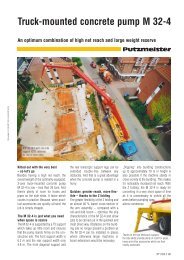
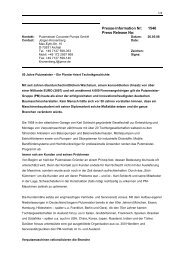
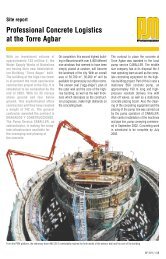
![Typenblatt CS 3095 [.pdf; 202.40 kb] - Putzmeister](https://img.yumpu.com/50530164/1/184x260/typenblatt-cs-3095-pdf-20240-kb-putzmeister.jpg?quality=85)
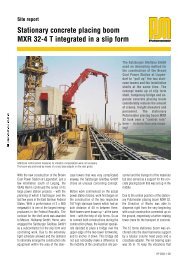
![M 47 Broşürü [.pdf; 527.92 kb] - Putzmeister](https://img.yumpu.com/49631771/1/190x141/m-47-brosuru-pdf-52792-kb-putzmeister.jpg?quality=85)
